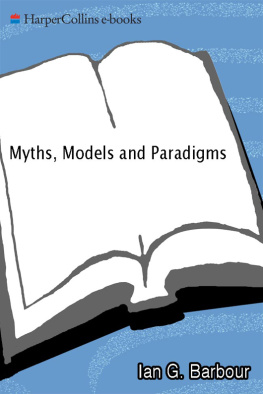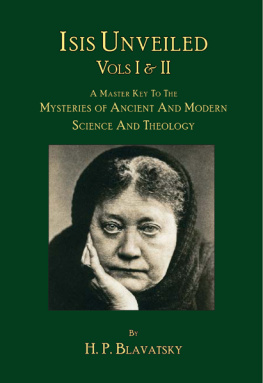Isis Unveiled: All Volumes
By H.P. Blavatsky
Foreword by Charles River Editors
www.charlesrivereditors.com

Helena Petrovna Blavatsky
1831 1891
INTRODUCTION
H.P. Blavatsky was born August 12th 1831 in Yekaterinoslav, Russia. After leaving Russia after an unconsummated arranged marriage, Helena became a prolific world traveler. She traveled the world with her second husband, Henry Steel Olcott, visiting Egypt, France, Germany, Mexico, South America, Canada, before settling in Madras, India.
There, she founded the Theosophical Society. Theosophy's all-encompassing worldview proposes explanations for the origin, workings and ultimate fate of the whole of Existence.
Isis Unveiled , published in 1877, is a book of esoteric philosophy, and was Blavatsky's first major work.
The book discusses or quotes, among others, Plato , the Chaldean Oracles , the Egyptian Book of the Dead , the Bible , Pythagoras, Apollonius of Tyana, the Popol Vuh , Paracelsus, Giordano Bruno, Marco Polo, Jesus the Nazarene, Siddhrtha Gautama, Zoroaster and Max Mller, as well as Buddhist , Brahmanical, Chinese, Persian, Babylonian, Chaldean, Syrian, Gnostic, Egyptian literature and much more. It is composed of two volumes, the first concentrating on science, and the second on religion.
This edition is specially formatted, includes the original illustrations, and a Table of Contents.
THE VEIL OF ISIS.
PART ONE.--SCIENCE.
CHAPTER I.
"Ego sum qui sum."-- An axiom of Hermetic Philosophy.
"We commenced research where modern conjecture closes its faithless wings. And with us, those were the common elements of science which the sages of to-day disdain as wild chimeras, or despair of as unfathomable mysteries."--BULWER'S "ZANONI."
THERE exists somewhere in this wide world an old Book--so very old that our modern antiquarians might ponder over its pages an indefinite time, and still not quite agree as to the nature of the fabric upon which it is written. It is the only original copy now in existence. The most ancient Hebrew document on occult learning--the Siphra Dzeniouta-- was compiled from it, and that at a time when the former was already considered in the light of a literary relic. One of its illustrations represents the Divine Essence emanating from ADAM * like a luminous arc proceeding to form a circle; and then, having attained the highest point of its circumference, the ineffable Glory bends back again, and returns to earth, bringing a higher type of humanity in its vortex. As it approaches nearer and nearer to our planet, the Emanation becomes more and more shadowy, until upon touching the ground it is as black as night.
A conviction, founded upon seventy thousand years of experience, ** as they allege, has been entertained by hermetic philosophers of all periods that matter has in time become, through sin, more gross and dense than it was at man's first formation; that, at the beginning, the human body was of a half-ethereal nature; and that, before the fall, mankind communed freely with the now unseen universes. But since that time matter has become the formidable barrier between us and the world of spirits. The oldest esoteric traditions also teach that, before the mystic Adam, many races of human beings lived and died out, each giving place in its turn to another. Were these precedent types more perfect? Did any of them belong to the winged race of men mentioned by Plato in Phaedrus? It is the special province of science to solve the problem. The caves of France and the relics of the stone age afford a point at which to begin.
As the cycle proceeded, man's eyes were more and more opened, until he came to know "good and evil" as well as the Elohim themselves. Having reached its summit, the cycle began to go downward. When the arc attained a certain point which brought it parallel with the fixed line of our terrestrial plane, the man was furnished by nature with "coats of skin, "and the Lord God "clothed them."
This same belief in the pre-existence of a far more spiritual race than the one to which we now belong can be traced back to the earliest traditions of nearly every people. In the ancient Quiche manuscript, published by Brasseur de Bourbourg--the Popol Vuh-- the first men are mentioned as a race that could reason and speak, whose sight was unlimited, and who knew all things at once. According to Philo Judaeus, the air is filled with an invisible host of spirits, some of whom are free from evil and immortal, and others are pernicious and mortal. "From the sons of EL we are descended, and sons of EL must we become again." And the unequivocal statement of the anonymous Gnostic who wrote The Gospel according to John, that "as many as received Him," i.e. , who followed practically the esoteric doctrine of Jesus, would "become the sons of God," points to the same belief. (i., 12.) "Know ye not, ye are gods? "exclaimed the Master. Plato describes admirably in Phaedrus the state in which man once was, and what he will become again: before, and after the "loss of his wings"; when "he lived among the gods, a god himself in the airy world." From the remotest periods religious philosophies taught that the whole universe was filled with divine and spiritual beings of divers races. From one of these evolved, in the course of time, ADAM, the primitive man.
The Kalmucks and some tribes of Siberia also describe in their legends earlier creations than our present race. These beings, they say, were possessed of almost boundless knowledge, and in their audacity even threatened rebellion against the Great Chief Spirit. To punish their presumption and humble them, he imprisoned them in bodies, and so shut in their senses. From these they can escape but through long repentance, self-purification, and development. Their Shamans, they think, occasionally enjoy the divine powers originally possessed by all human beings.
The Astor Library of New York has recently been enriched by a facsimile of an Egyptian Medical Treatise, written in the sixteenth century B.C. (or, more precisely, 1552 B.C.), which, according to the commonly received chronology, is the time when Moses was just twenty-one years of age. The original is written upon the inner bark of Cyperus papyrus, and has been pronounced by Professor Schenk, of Leipsig, not only genuine, but also the most perfect ever seen. It consists of a single sheet of yellow-brown papyrus of finest quality, three-tenths of a metre wide, more than twenty metres long, and forming one roll divided into one hundred and ten pages, all carefully numbered. It was purchased in Egypt, in 1872-3, by the archaeologist Ebers, of "a well-to-do Arab from Luxor." The New York Tribune , commenting upon the circumstance, says: The papyrus "bears internal evidence of being one of the six Hermetic Books on Medicine, named by Clement of Alexandria."
The editor further says: "At the time of Iamblichus, A.D. 363, the priests of Egypt showed forty-two books which they attributed to Hermes (Thuti). Of these, according to that author, thirty-six contained the history of all human knowledge; the last six treated of anatomy, of pathology, of affections of the eye, instruments of surgery, and of medicines. * The Papyrus Ebers is indisputably one of these ancient Hermetic works."
If so clear a ray of light has been thrown upon ancient Egyptian science, by the accidental (?) encounter of the German archaeologist with one "well-to-do Arab" from Luxor, how can we know what sunshine may be let in upon the dark crypts of history by an equally accidental meeting between some other prosperous Egyptian and another enterprising student of antiquity!
Next page










